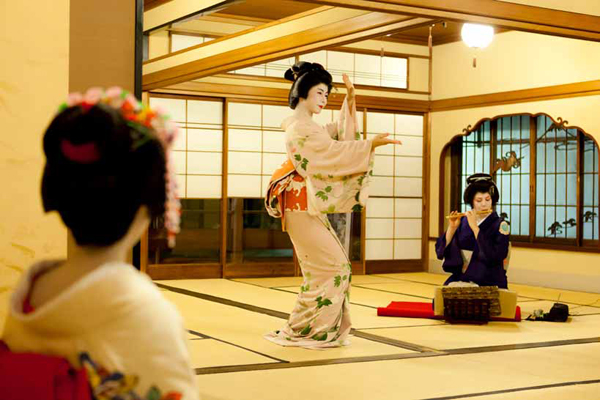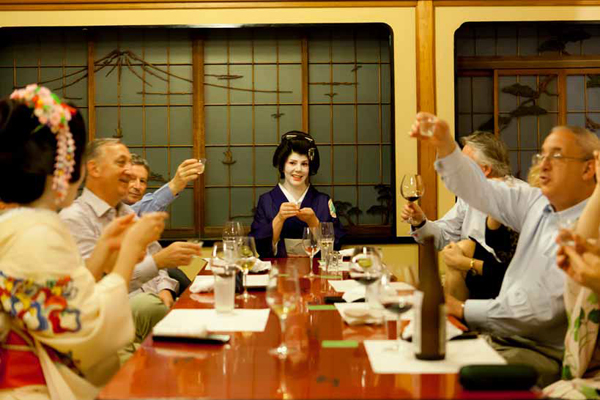If you take a stroll through one of Tokyo’s hanamachi, or geisha districts, you may be lucky enough to catch a glimpse of one of the city’s most elusive denizens.
In Asakusa, in Shinbashi, in Mukojima; a rustle of silk, a lowered parasol, a flash of red lipstick in a snow-white face. In the twenty-first century, their numbers are dwindling, but geisha can still be seen, usually in the evening time, venturing out to teahouses to entertain Tokyo’s high society.
Geisha translates into English as ‘entertainer’ or ‘artist’. A commonly held misconception in the West equates geisha with prostitute, but the practitioners of these arts in Japan today would balk at such a suggestion. Their role is to provide for their clients a superlative social experience.
They entertain at banquets or drinks events with music, dance and elegant conversation; they are masters of the traditional arts. Geisha are subtly sensual and even provocative, but sex is a private issue, and not at all part of the job.
The ‘flower and willow’ world is increasingly exclusive. In the heyday of the 1920s around 80,000 geisha were practising in Japan. They were the celebrities of their day; the most famous became the faces of cosmetics and luxury food brands, and were worshipped by the public in a manner akin to the Hollywood actresses of the West.
Today, roughly one thousand geisha remain throughout Japan, and they have long ceased to be available to a mass audience. Far from the high visibility they enjoyed in the pre-war years, the modern geisha is available usually only to an elite number of people lucky enough to have the connections and money to comprise her clientele.
The geisha’s salvation may lie in an unlikely quarter. Sayuki, originally from Australia, is the world’s first foreign geisha.
The Oxford educated anthropologist was admitted into a geisha house in Tokyo initially as part of an academic project, and made her formal debut in 2007. She is the first non-Japanese person to practise as a geisha, and is now working hard to promote the culture she has adopted. She explains the reasons behind the geisha world’s increasing exclusivity:
“After the war geisha had to go underground a bit, as it was uncertain how they would be treated during the occupation. Their world became much more private, secretive; only the select few could access it. And this quality of elitism has prevailed for many decades. Today, the average Japanese person has never met a geisha, and has absolutely no idea how to go about doing so.”
There is, however, still great demand for their services, as Sayuki assures, “People find geisha fascinating. They are remnants of a bygone era; of a culture people – Japanese and foreign – still want to experience. And they are savvy and witty entertainers with skills to ensure that any customer has a wonderful time.”
How does one, then, go about meeting with a geisha? Traditionally, it cannot be achieved without a formal introduction into the geisha house and even for those who possess the requisite connections, prices geisha charge to attend parties can be prohibitively expensive. No small wonder, then, that for the majority of people in Japan, geisha remain an elusive, unobtainable ideal. Sayuki, however, is changing this.
“Tea-houses still need an introduction but customers can contact me through my web-site and I become the introduction. There are all kinds of customers with all kinds of budgets. I ask customers to tell me how many they are and what their maximum budget is per person. And then I can give them some options to suit them. I have single businessmen alone on business trips, or tourist couples. I have high school groups in afternoon banquets and groups of snowboarders on their way to Hakuba.
One popular thing lately is expats inviting geisha to a party in their homes. Some customers just want to have drinks with geisha rather than a full multi-course dinner and that is a lot cheaper too. Perhaps I am doing something new in making this world more accessible to new types of customers. But then geisha have always been very strong, independent businesswomen, and it’s merely a matter of adapting the model to the times.”
Sayuki’s commitment to preserving geisha culture is perhaps surprising to find in a foreigner, but this Australian has been passionate about Japan since her youth.
Her first visit to the country was as an exchange student at the age of fifteen, when she enrolled in a Tokyo high school, and went on later to study at the prestigious Keio University – then onto a Japanese company at which she worked for two years. Fluent in Japanese, she has worked hard to truly belong in the culture she has adopted.
“Training to be a geisha is incredibly challenging,” she says. “A lot of girls leave after only a few days; they’ve completely underestimated what it takes to be a geisha or hangyoku (trainee geisha or maiko). There are informal lessons in everything: how to sit, how to stand and how to speak, as well as formal lessons in musical performance and dance. It encompasses your whole life.
There’s also a very strict hierarchical system within the geisha house, and new geisha must always submit to their elders.” She admits, “It can be very tough. Being a foreigner in an unprecedented position, I always felt I had to work to prove myself.”
Sayuki’s attempts to render the geisha world more accessible to outsiders stem from a desire to see geisha participate once again in mainstream culture, and secure the continuance of a tradition which is in danger of dying out in the twenty-first century.
In a gesture which further illustrates her commitment to the culture’s preservation, this year has seen Sayuki begin to support the training of a prospective hangyoku (the name for maiko specific to Tokyo), helping the twenty year-old achieve her dreams of becoming a geisha.
If she succeeds she will be one of only seven hangyoku (maiko) in Tokyo, and will be the first to be supported by a non-Japanese geisha, though Sayuki will arrange for her to learn her lessons with the help of much more senior teacher.
“I want to do all I can to help preserve this beautiful tradition,” says Sayuki. “I am honoured to have been allowed to be a part of it, and I’m happy to do everything in my power to contribute.”
By May Baker
Sayuki can be contacted through her website.










